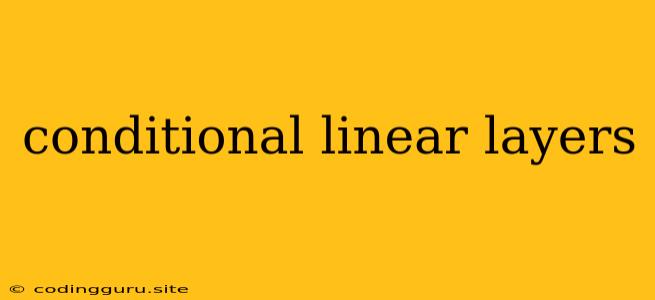Understanding Conditional Linear Layers: Adapting Your Neural Networks
In the realm of deep learning, neural networks are designed to extract complex patterns from data. However, often we want our models to be more adaptable and responsive to specific conditions or inputs. Enter conditional linear layers, a powerful technique that enables your neural network to dynamically adjust its behavior based on given context.
What Are Conditional Linear Layers?
Imagine a scenario where you're building a model to generate different types of text, such as poems, news articles, or code. A traditional linear layer will have fixed weights and biases, leading to a uniform output irrespective of the desired text style.
Conditional linear layers address this limitation by introducing a mechanism to dynamically modify the layer's weights and biases based on a condition or input. This condition could be anything from a specific text prompt to an image, allowing your model to produce outputs tailored to the given context.
Why Use Conditional Linear Layers?
Flexibility and Adaptability: Conditional linear layers allow your models to be more adaptable and responsive to specific inputs or conditions.
Improved Performance: By tailoring the behavior of the layer based on the input, conditional linear layers can often lead to improved performance in tasks like text generation, image classification, and more.
Reduced Complexity: In some cases, using conditional linear layers can be simpler than adding additional branches or layers to your network to achieve the same level of adaptability.
How Do They Work?
The core concept of conditional linear layers is to dynamically adjust the layer's weights and biases based on the provided condition. This can be accomplished using various techniques, including:
- Conditional Weighting: Instead of having fixed weights, the weights are generated or modified based on the input condition.
- Conditional Biasing: The biases of the layer are adjusted based on the input condition.
- Conditional Scaling: The output of the layer can be scaled or normalized based on the input condition.
Examples of Conditional Linear Layers
1. Text Generation with Style Control: You could use a conditional linear layer to control the style of generated text. The condition could be a specific text prompt or a style label.
2. Image Classification with Dynamic Attention: A conditional linear layer could be used to dynamically focus the model's attention on specific regions of an image based on the classification task.
Implementing Conditional Linear Layers
1. Using Libraries: Popular deep learning libraries like PyTorch and TensorFlow offer functionalities for creating conditional linear layers. These libraries provide pre-built modules or functions to incorporate conditional behavior within your model.
2. Custom Implementation: If the available libraries lack the specific functionality you need, you can implement your own conditional linear layer using basic matrix operations.
3. Combining Techniques: You can also combine multiple techniques to create more complex and sophisticated conditional linear layers.
Conclusion
Conditional linear layers offer a valuable approach to enhancing the adaptability and flexibility of your neural networks. By dynamically adjusting the layer's behavior based on input conditions, you can achieve improved performance, reduced complexity, and greater control over your model's output. Remember, the specific implementation and design of conditional linear layers will depend on your particular task and the desired level of adaptability.
